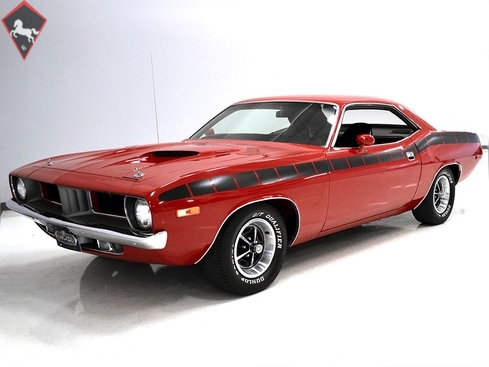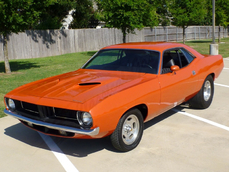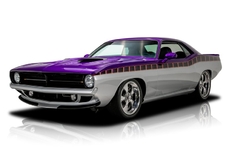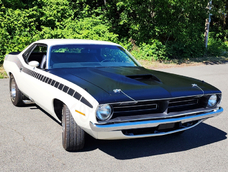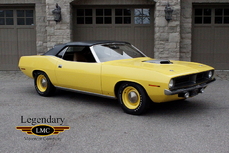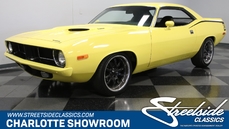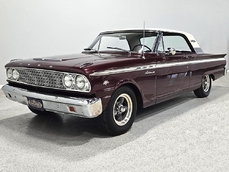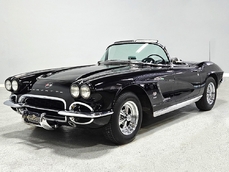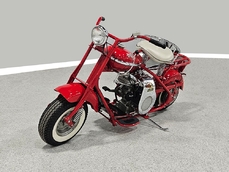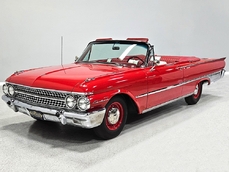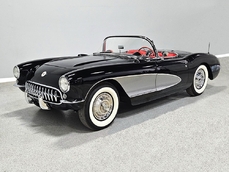Plymouth Cuda 340 cubic inch V8 1972
Allmän beskrivning :
Chrysler was late to the pony car party, but there’s a very good argument to be made that by being last, they could also be the best. Watching what Chevy and Ford were doing with the Camaro and Mustang, respectively, meant that Chrysler could build the ideal pony cars when they dropped the all-new E-bodies in 1970. There are few who will argue that the Plymouth ‘Cuda in particular, isn’t a great-looking car with ideal proportions and the engineering to handle any powerplant you wanted, from a six-cylinder to a HEMI. Long, low, and sleek, the ‘Cuda nails the archetypal pony car look with a hood that’s nearly six feet long and a short deck, making it look very muscular indeed. Add in Chrysler’s innovative torsion bar suspension and you get a car that goes fast but doesn’t mind bending itself into a corner.
By 1972, the HEMI and other big block engines were history, but that doesn’t mean the party was over. In fact, we find it to be quite the opposite, because this 1972 Plymouth ‘Cuda 340, with its lightweight small block V8, is an absolute blast to drive. The fender tag is full of options that make it worth owning, too:
BS23:
Plymouth Barracuda
Special, 'Cuda
2 Door Hardtop
J2B: Unknown
1972
Dodge Main, Hamtramck, MI, USA
162345: Sequence number
E55: 340 cubic inch 4-barrel V8, 275 horsepower
D13: 3-speed manual transmission, floor shift
FE5: Red exterior color
A6X9: Trim - Basic, vinyl bucket seats, black
000: Full door panels
915: Build Date: September 15
145785: Order number
FE5: Red top color
U: USA specifications
B51: Power brakes
C56: Bucket seats
G36: OS dual racing mirrors
J25: 3-speed wipers
J54: Sport hood
M21: Roof drip rail moldings
M25: Wide sill moldings
M31: Belt moldings
M88: Decklid moldings treatment
N23: Electronic ignition system
N41: Dual exhaust
N42: Chrome exhaust tips
N85: tachometer
R11: Radio, solid state AM (2 watts)
V6X: Longitudinal stripes, black
26: 26-inch radiator
EN2: End of Sales Codes
The styling is the same as the dramatic 1970 cars, and for some reason, Plymouth returned to single headlights after one year of having two per side. Hmmm. There’s still an aggressive-looking J54 Sport Hood with twin snorkels and hood pins, and V6X strobe stripes down the flanks look best on the ‘Cuda thanks to the dramatic kick-up behind the doors. FE5 Bright Red is this car’s original color and it was repainted a few years ago in that vivid red hue, so it looks great today. There’s no evidence this was ever a rusty car and we believe the floors, quarters, trunk extensions, and rockers are all original sheetmetal with zero signs of failure or previous damage. The doors fit surprisingly well, especially for a Mopar, and gaps all around are uniform, suggesting that they took their time putting it back together. We like the slick, smooth look of the plain deck lid, and this 340 received the same cool exhaust ports in the rear valence that the HEMI cars received, so it certainly looks the part of a performance machine. Nice chrome bumpers, stainless trim that was obviously polished when it was restored, and a very clean grill all add up to one great-looking ‘Cuda that’s ready to rumble.
The black vinyl interior has been restored as well, using correct reproduction seat covers, fresh black carpets, and door panels that fit right. The dash pad is probably original, as there’s a small split in the middle, but that’s a fairly minor issue on a car that gets so many things right. There’s a full complement of Rallye gauges, including a tachometer, and they all work properly except the clock, which is typical. This was originally a 3-speed manual car, but at some point it was upgraded to a TorqueFlite automatic, and the center console was changed to match so it has an OEM look. The factory two-spoke steering wheel is in excellent condition and the original Music Master AM radio has been swapped out for a far better AM/FM/cassette head unit that sounds pretty darned good through those big Sony speakers on the rear package shelf. The back seat looks almost completely unused, while the trunk has been upholstered in matching black carpets that include a custom spare tire cover to give it a neatly finished appearance.
We have every reason to believe that the 340 cubic inch V8 under the hood is the original, numbers-matching piece, although when it was rebuilt the block was decked, wiping out the numbers beyond the “H” date code, denoting a 1972 block. Regardless, it was given a few invisible upgrades including a slightly larger cam and some port work on the heads, so it’s a great runner. There’s an Edelbrock intake manifold and 4-barrel carburetor on top and Hemi Orange covers the block itself. The factory electronic ignition is supplemented by a high-output coil and yellow plug wires that really pop in the red engine bay. A few chrome dress-up pieces look great and you’ll note that this car has both power steering and power brakes, so it’s a pleasure to drive. It starts easily, idles well, and pulls like there’s a legitimate 300 horsepower on tap. There’s torque at any speed and after running it around the neighborhood, you might wonder why anyone would need or want a big block, especially since this one loves to go around corners. Long-tube headers were added to bolster the engine’s torque curve and there’s a giant 26-inch radiator up front, you know, the same one used on the Hemi, so you won’t have to worry about this one getting too hot.
As I mentioned, the original 3-speed manual was swapped out for a rugged 3-speed TorqueFlite automatic transmission. Why, I don’t know, but the conversion was done using all OEM components so it looks and acts like the factory did it. The floors are bright red, like the bodywork, and there are no signs of patches or rust issues anywhere. You can still see the spot welds on the factory pinch weld on the rockers and all the seams are laser sharp, so this car obviously lived someplace warm. Out back, it feels like there are 3.54 gears in an 8.75-inch rear end, so it’s an easy cruiser with plenty of punch, and at 65 MPH, it’s actually comfortable and quiet. The torsion bar suspension rides surprisingly well and this is one muscle car that doesn’t mind changing directions, because the handling is crisp and steering sharp. It tracks straight, the brakes are reassuringly firm and powerful, and those fat 245/60/14 Dunlop radials fill the fenders perfectly. This car definitely gets the important stuff right.
This isn’t a pedigree car but worrying about that kind of stuff always takes the fun out of car ownership anyway. It is, however, quite faithful to the original recipe and the driving experience is great all around. If you like the ‘Cuda look (who doesn’t?) then this represents a very affordable way to drive your dream and still get plenty of performance to go with it. Call today!
http://www.harwoodmotors.com/vehicles/inventory_details.php?id=752
1972 Plymouth Cuda 340 cubic inch V8 is listed såld on ClassicDigest in Macedonia by for Ej prissatt.
Fakta i bilen
Karosstyp : Personbil Märke : Plymouth Modell : Cuda Modellversion : 340 cubic inch V8 Motorvolym : 0.0 Årsmodell : 1972 Läge : Ohio
Såld
Information om säljaren
Såld
People who viewed this Plymouth Cuda also viewed similar Plymouth listed at ClassicDigest
Other cars listed for sale by this dealer
om Plymouth
Plymouth -varumärket hade en betydande inverkan på bilindustrin från början till dess eventuella avbrott. Här är en översikt över Plymouth som täcker dess historia, anmärkningsvärda modeller och specifikationer:Tidiga år och stiftelse:
Origins (1928): Plymouth introducerades av Chrysler Corporation som ett prisvärt varumärke på mellannivå som riktar sig till budgetmedvetna konsumenter.
Framgångsfaktorer: Det fick popularitet på grund av dess pålitliga konstruktions-, prisvärd och smarta marknadsföringskampanjer.
Anmärkningsvärda modeller:
Plymouth Road Runner (1968-1980):
Ikonisk muskelbil: känd för sin prestanda, överkomliga och minimalistiska design.
Specifikationer: Erbjuds olika V8 -motoralternativ med kraft från 335 till 390+ hästkrafter.
Plymouth Barracuda (1964-1974):
Muskelbilskonkurrent: Placerad som en sportig konkurrent inom muskelbilsegmentet.
Specifikationer: Motoralternativ inkluderade V8 med kraftuttag som varierar mellan 145 till 425+ hästkrafter.
Plymouth Fury (1955-1978):
Livslängd: En av Plymouths längstproducerade modeller, tillgängliga i olika kroppsstilar.
Tekniska funktioner: Motoralternativ inkluderade V8 med kraft från 215 till 375+ hästkrafter.
Plymouth Valiant (1960-1976):
Kompakt bil: introducerad som en kompakt bil, känd för sin hållbarhet och tillförlitlighet.
Motorspecifikationer: presenterade inline-SIX- och V8-motorer med kraft som sträcker sig från 100 till 235+ hästkrafter.
Nedgång och bortgång:
Senare år: Plymouth mötte utmaningar på grund av varumärkesutspädning inom Chrysler Corporation och ökade konkurrensen från andra märken.
Avbrott: Varumärket kämpade på 1990 -talet mitt i företags omstrukturering och minskande försäljning. Plymouth upphörde produktionen 2001 som en del av Daimlerchryslers effektiviseringsinsatser.
Arv och påverkan:
Plymouths arv ligger i sina bidrag till det amerikanska billandskapet och erbjuder pålitliga, prisvärda och eleganta fordon. Medan det mötte utmaningar under de senare åren och slutligen upphörde produktionen, förblir flera av dess ikoniska modeller, särskilt de i muskelbilen, firade bland samlare och entusiaster och lämnade ett bestående märke på bilhistoria.
